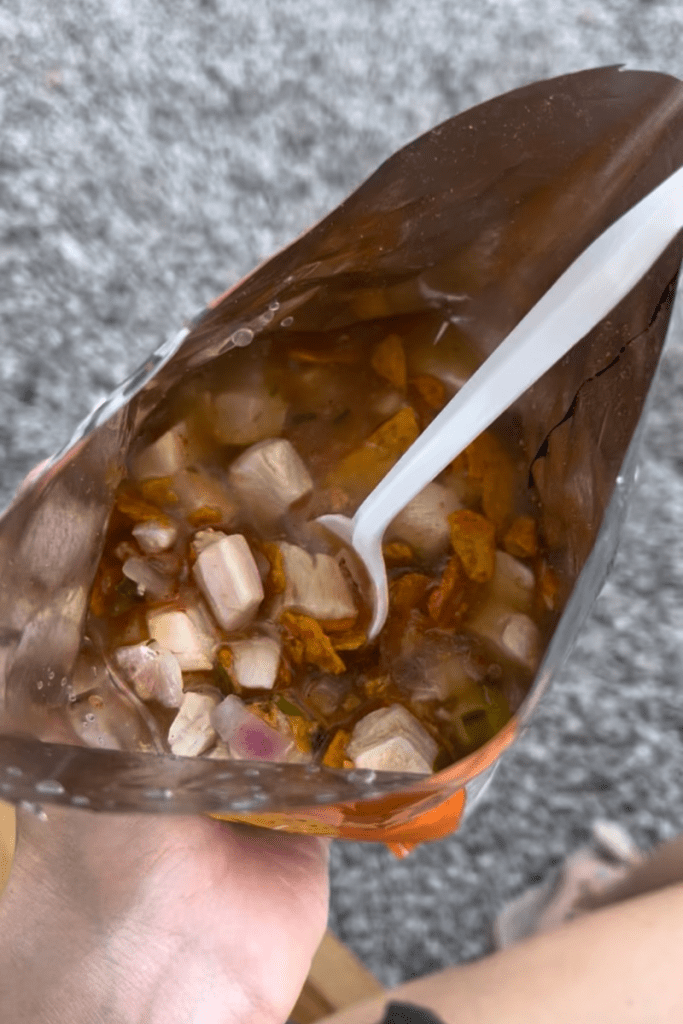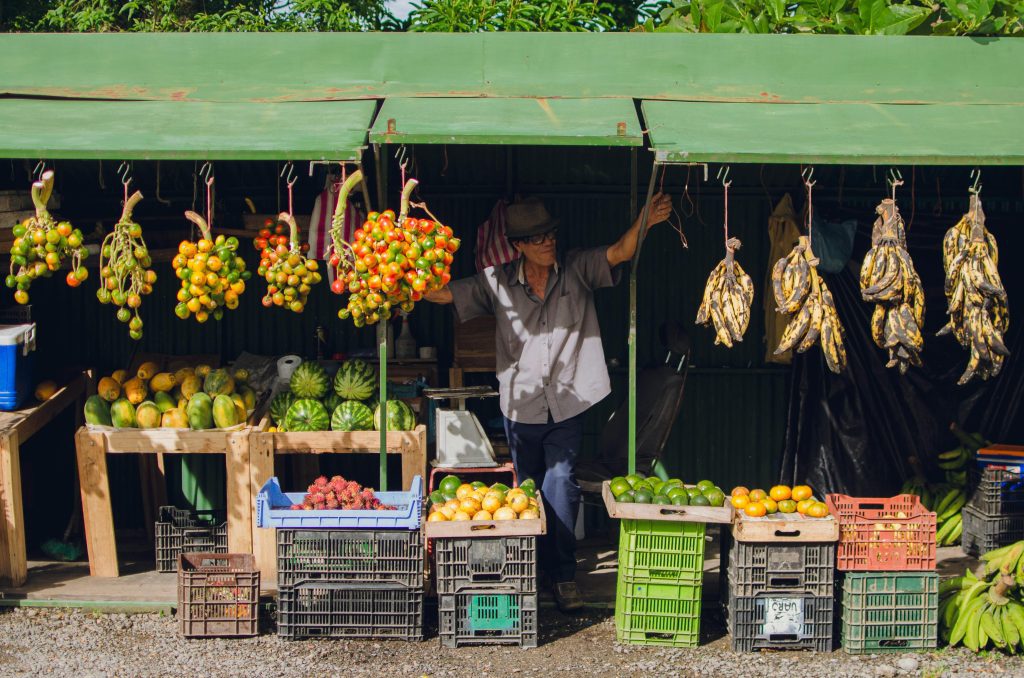Is Costa Rica expensive?
Costa Rica is one of the priciest countries in Central America. There’s a reason it’s called the Switzerland of Latin America! This is especially true for touristy destinations in Costa Rica. Come with the expectation that you will be spending some money, especially on tours, groceries, and meals out.
That being said, there are lots of ways to save money. The more authentic places you shop and dine, the lower your bills. You can also stay further out of town to save some money on your accommodations.
This post may contain affiliate links, which means that purchases through the links listed may give me a small commission at no extra cost to you.
Can you eat the street food in Costa Rica?
Street food is not as common as in Mexico or some other Latin American countries. When you do see a street food, look for the vendors that have earned the locals’ trust (have a line or are being frequently purchased from). I’ve never had a bad experience with street food, and I almost always take the chance!


What kinds of street food should you try in Costa Rica?
Caldosas are a kind of ceviche (raw fish cooked in lime juice) with crunched up chips in them. They’re usually served in a small bag of chips! Another great street food are pinchos, which is just a skewer of grilled meat. Granizados are a shaved iced desert with fruity flavors and condensed milk! There are usually vendors that come around with a cart at the beach. Lastly, pipas are small, green coconuts. They’re usually opened with a machete the moment you order them! They are incredibly refreshing and a great natural source of electrolytes.


What happens if you get sick in Costa Rica?
Costa Rica has universal healthcare, which means that public hospitals will serve anyone. If you have some kind of emergency in Costa Rica, you will be able to get the help you need without it costing you an arm and a leg. Similarly, if you get sick or develop some other medical issue, there are private hospitals and doctors that are inexpensive and of high quality.
If you just need medicine, check out your local pharmacy! Costa Rica pharmacies usually have a doctor on staff who is there to answer questions and prescribe you medicine. Pharmacies may not have the exact brand of medicine you normally take, but there is still a wide variety. If you’re wondering what kinds of medication to bring in your travel bag, check out the Costa Tica Storefront on Amazon.
Can you drink the water in Costa Rica?
Just about every blog will tell you that, yes, you can drink the water in Costa Rica. The water is treated but there are some rural places in which you should stick to bottled water, such as Tortuguero and Osa Peninsula.
However, if you have a sensitive stomach, I would suggest opting for bottled water. After two years of living in Costa Rica, and almost continuous stomach problems (which Costa Ricans referred to as “gastritis”), I decided to try drinking bottled water. It almost completely alleviated my issues. Water in Costa Rica is known to have a lot of limestone in it which can be hard on your stomach, and over time can cause kidney stones. If you are prone to kidney stones, have an autoimmune disorder, or a sensitive stomach, stick to bottled water.
That being said, there is no concern with brushing your teeth with water from the faucet, washing your fruit under tap water, etc. The water is clean, although it may have many minerals and a healthy dose of chlorine to keep it disinfected.
One thing to keep in mind is to thoroughly wash any fresh fruits or vegetables to ensure you rid it of any tiny organisms or parasites. Enjoy all the fresh fruit and veggies there are in Costa Rica, just be sure they’re well washed!
How much cash should I bring?
You will need cash for tips (for guided tours/activities or at restaurants), paying the people who look after your parked car, street vendors, and bus/ferry tickets. Just about any other business will take credit cards. There are also plenty of ATMs throughout Costa Rica to get US dollars or Costa Rican colones.
I would suggest bringing at least $100-200 cash to avoid paying ATM fees. It is important to bring pristine USD bills. Costa Rica is very picky about the bills they will accept. They will send you away if your money is ripped or scribbled on.
Since you will want some cash on you at all times, I suggest bringing a debit card with no international ATM fees. This is a game changer, since you can get cash (US Dollar or Costa Rican Colones) from any ATM without paying the usual $5 fee for each transaction. Charles Schwab has a great debit card with 0 ATM fees.
Paying with a credit card is widely accepted, but it is important to bring a Visa or Mastercard—NOT an Amex or Discover. Amex and Discover are rarely accepted. Also, be sure to bring a card that has no foreign transaction fees. When traveling, I opt for my Chase Sapphire Preferred card since it has no foreign transaction fees.
Do I need a visa to go to Costa Rica?
Costa Rica separates countries into four groups. Each group has different visa requirements. The first group of countries includes the United States, Canada, many European Union countries, and some other countries. These countries do not need a visa. Citizens of these countries will receive a stamp that will enable them to stay in Costa Rica for up to 180 days. However, ensure your passport is signed and does not expire during your trip.
If you are unsure of which group your country belongs to, it’s best to check with your country’s Costa Rica embassy/consulate.
Do I need to know Spanish to go to Costa Rica?
You do not need to know Spanish to be able to get around Costa Rica. Tourism is a huge part of the Costa Rican economy so many Costa Ricans work hard to learn English, especially if they work in the tourism industry. It is appreciated, however, when tourists learn some basic phrases. If you are looking for an opportunity to practice your Spanish, have at it!
While many Costa Ricans speak English, that does not mean that everyone you interact with will speak it. If you stay in a family-owned hotel or visit a local restaurant, the people there may not know much English. Bus or taxi drivers may know little to no English at all.
If you are visiting anywhere that is not a major tourist destination, it’s best to learn some basic phrases and become familiar with using Google Translate (make sure it’s downloaded to work offline!).
What should I pack for Costa Rica?
Costa Rica is a tropical country that is very near to the equator. It has two seasons: a rainy season and a dry season. Packing for Costa Rica depends a bit on where you travel to and what time of the year it is. Generally, you will be packing light clothes like shorts and T-shirts, but you will also want to bring a few long pants and a jacket or two, as well.
For a complete packing list that details everything you should bring depending on the time of year, check out this post.


Essential Info for Traveling Costa Rica:
🔹 Costa Rica Planning Guide – Trip planning 101
🔹 Deciding when to come to Costa Rica
🔹 10% off your rental car – Costa Rica’s most reliable company
🔹 Safety Tips to enjoy your trip to the fullest
🔹 The Ultimate Packing List for Costa Rica
